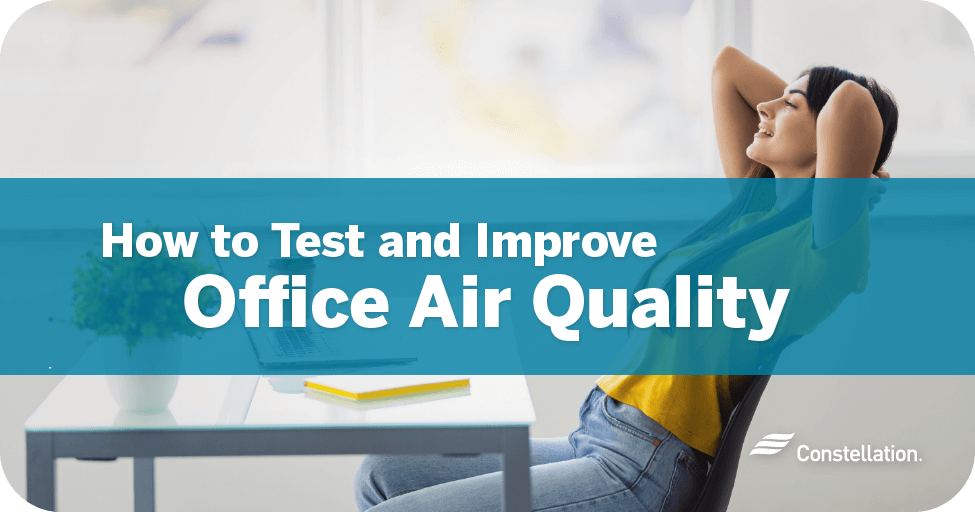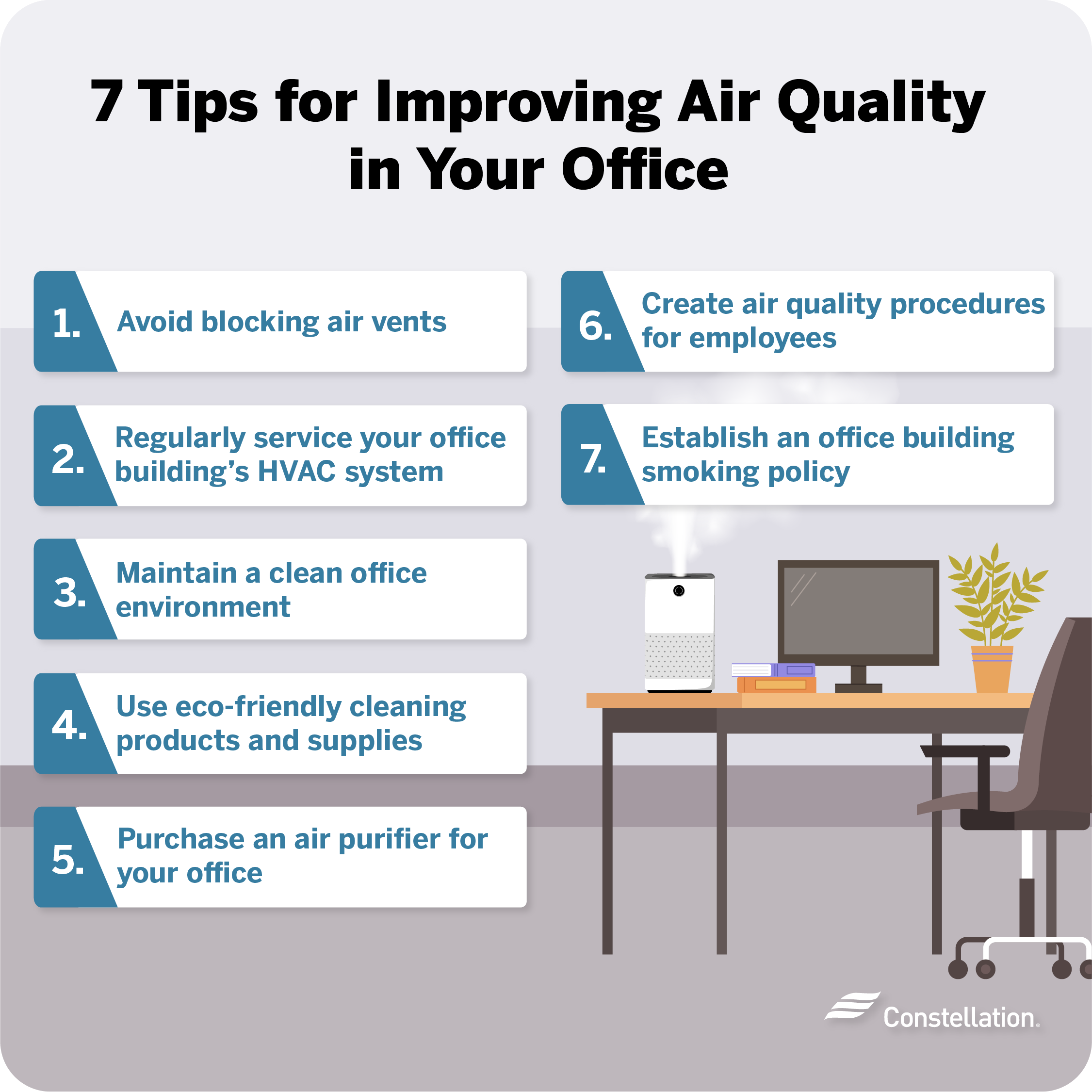
- Category:
Small Business Energy Savings -
Last updated:
July 11, 2024
How to Test and Improve Office Air Quality
Office air quality is getting more attention. COVID highlighted the need for clean air and now, wildfire smoke is raising similar concerns, meaning indoor air quality is back in the headlines.
You can’t usually see office air quality problems, but they are worth your attention. Since you and your workers spend huge chunks of the day indoors, you will reap health and productivity benefits when you improve office air quality. We’ve gathered these tips to make it easier.
What causes poor indoor air quality in office buildings?
Before exploring how to improve indoor air quality in an office, here are the primary causes of poor air quality:
- Presence of air pollution sources. The Centers for Disease Control and Prevention indicates several potential sources of indoor air pollution. Biologic agents include disease-causing bacteria, viruses, and molds, along with animal dander and saliva, dust mites, pollen, and cockroaches. Other pollutants include asbestos, certain building materials, radon, tobacco smoke, wood stoves, gas range, or other heating devices.
- Inadequate ventilation. If you don’t have plenty of fresh air coming in and stale air moving out, pollutants build up inside. Without clean and effective HVAC filters, you could bring outdoor pollutants indoors. Good ventilation will help in keeping your business cool in the summer.
- High or low humidity levels. How much moisture is in office air affects indoor air quality. Dampness can degrade materials in your offices that vaporize into the air. Mold and other microbes may flourish. Low humidity can dry out the protective mucus membranes, causing irritation and lowered resistance to disease.
- Improper use of buildings. Using a building for a new purpose, you increase the risk of office air quality issues. If your office is in a converted factory, chemicals embedded in the structure can leak out. If you are doing business in a converted barn, you may need to deal with biologic pests or pathogens in the air.
7 tips for improving air quality in your office

How to improve indoor air quality in an office is a matter of a bit of effort and knowledge.
1. Avoid blocking air vents
One of the fastest ways to improve office air quality is with good ventilation. Be sure nothing blocks air vents. For your office’s ventilation system to work as designed, it is vital that all intake and outflow vents are free of obstruction. Avoiding electricity waste is an added benefit.
2. Regularly service your office building’s HVAC system
Make sure your HVAC system is running smoothly with seasonal service in the fall and winter. Don’t stop there. Change your air filters often. It is an easy and inexpensive way to instantly improve office air quality. It will also reduce office HVAC energy consumption.
Does air conditioning clean the air of wildfire smoke?
If your HVAC has HEPA filters, it may help to clean the air a little bit. Most systems don’t. Help keep smoke out by switching the system to recirculate air and shut off exhaust fans.
3. Maintain a clean office environment
Keep surfaces clean. Dust fills the air with particulates and breeds mold, bacteria, mites and other insects. Pay special attention to break rooms, kitchens, and bathroom surfaces. Vacuum floors and dust blinds often. You can reduce small business cleaning costs, yet still keep your office building indoor air quality high.
4. Use eco-friendly cleaning products and office supplies
When keeping your office clean, pay attention to your cleaning products. Many emit harsh chemicals, even so-called natural products. Products made with pine and citrus oils contain terpenes, which can combine with materials around your office to create formaldehyde, a known carcinogen. Look for products labeled as Safer Choice by the EPA to help minimize risks.
5. Purchase an air purifier for your office
There’s only so much you can do to keep pollutants out. One method for improving indoor air quality in an office is to use air purifiers. Choosing an energy-efficient air purifier will remove a broad spectrum of pollutants, while having little effect on your energy bill. Constellation has collected some of the best air purifier models and makes them conveniently available to you. You may find it worthwhile to also choose an energy-efficient dehumidifier that helps to keep air clear of moisture-loving microbes.
6. Create air quality procedures for employees to follow
Employees can help improve indoor air quality in the office. Encourage clean work spaces, free of clutter. Discourage having food in work areas. Centralize food garbage in the kitchen or break room. If anyone sees water damage, report it right away to prevent mold growth. Keeping plants around work spaces does more to brighten up the area. Some, like peace lilies, snake plants, ferns and spider plants are highly effective in filtering air.
7. Establish an office building smoking policy
Most jurisdictions prohibit smoking in the office. Strengthen the policy by requiring smokers to stand a certain distance away from windows and doors to your building. Office etiquette signs remind your staff of the rules and benefits of not smoking.
What are the indoor air quality standards for office buildings?
Setting indoor air quality standards for office buildings is not straightforward. OSHA has not specified regulations, but suggests subjective qualities, such as a comfortable-feeling temperature and humidity, adequate fresh air, and minimal pollutants. ANSI/ASHRAE has specified Standard 62.1-2022, however the book is expensive. Use your best judgment and seek the opinions of your employees.
Ways to check the air quality in your office
While there are not yet indoor air quality standards for office buildings, you can set your own standards for your particular place of business. Many people wonder: How can I measure air quality in my office? There is no single method, but these tools will help you keep tabs on key aspects of clean air.
- Purchase carbon monoxide detectors. Devices that detect this lethal gas are as important to have in your place of business as a smoke detector.
- Get a radon detector. Sensors for this cancer-causing gas warn you if you have a problem.
- Invest in an indoor air quality monitor. These devices check for a variety of pollutants, such as volatile organic compounds, smoke and airborne particles,carbon monoxide and radon.
- Test for mold.Test kits help you monitor the presence of mold spores on various surfaces.
- Keep an eye on air quality index numbers. Most weather sites now post air quality conditions along with wind and temperature. When outdoor air is bad, turn your HVAC to recirculate and increase the use of HEPA filters.
Why is office building indoor air quality important?
Maintaining healthy indoor air quality in your office building will contribute to a healthy and productive work environment. Poor air quality can lead to headaches, feeling tired, concentration problems and irritation in the eyes, nose, throat and lungs. More serious complications from bad air include asthma and cancer. Learn how to check air quality in your office and then how to make air quality improvements. You, your employees, and your office visitors will all benefit.




